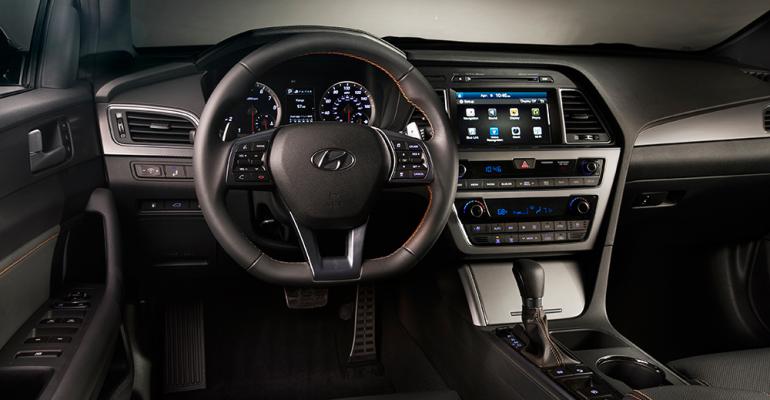Hyundai pulls the wraps off the U.S. version of the next-generation Sonata sedan today at the 2014 New York International Auto Show.
The ’15 Sonata late last month had its global debut in South Korea and, judging by specifications released by the U.S. unit of the automaker, there are just a few differences between the regional variants.
The U.S. model wears the same restrained design language seen in pictures of the Korean-market model, a purposeful decision on Hyundai’s part.
“With the 2011 Sonata, Hyundai took the midsize sedan from a meal to a gourmet dinner,” Chris Chapman, chief designer-Hyundai Design North America, says in a statement. “The evolution to…more taut, modern lines reflect the improvements in refinement and driving dynamics for 2015.”
Hyundai Motor America CEO Dave Zuchowski told WardsAuto recently Hyundai’s doesn’t need to yell for attention anymore in the midsize sedan segment, where the outgoing Sonata made its mark with aggressive styling.
Hyundai uses adjectives like energetic, crisp, smooth and subtle to describe the ’15 4-door’s sheetmetal.
The car’s face perhaps is the most obvious change, with a larger, less elaborate grille than its predecessor.
The U.S. version’s Sport grade has a metallic-look grille compared with the black grille on the Korean-market base model revealed two weeks ago.
The Sport grade also gets a unique lower grille, with a mesh pattern insert vs. the base car’s horizontal-bar design.
A more tightly stretched beltline and a larger window graphic in the rear are two profile differences between incoming and outgoing generations.
SE base-grade Sonatas in the U.S. get standard 16-in. alloy wheels, a rear lip spoiler and LED daytime running lights. Buyers of the sedan’s Limited grade get those items as well as rocker-panel extensions and dual-exhaust pipes.
The Sonata Sport gets chrome molding on its sides and, in models with a 2.0L turbocharged engine, quad exhaust tips and 18-in. alloy wheels.
Interior photos reveal the same straightforward layout seen in the Korean-market Sonata, with a center stack angled toward the driver and a variety of large hard buttons.
“Controls are grouped logically and placed in the most convenient position for the driver,” Hyundai says, adding it met with various interior suppliers to achieve a unified look and feel for controls.
For better visibility, the display screen moves higher up the center stack for ’15, and the steering wheel was closely studied and reworked, giving it the “ideal diameter, shape and tactile feel,” the automaker says.
The athleticism of the Sport 2.0T grade is reflected in its interior, which gets a D-cut steering wheel and paddle shifters, as well as a sport-instrument cluster with a needle at the 6-o’clock mark.
Cabin noise has been reduced via smaller apertures in the Sonata’s bulkhead, greater usage of sound-deadening materials in the dashboard, and sound-absorbing materials placed under the floor pan.
Engine notes also are re-tuned to be “pleasing to the ear without being intrusive,” Hyundai says.
Fibrous-glass expansion board in the underbody tray not only deadens road noise but also is said to improve aerodynamics.
Small Tweaks Made to Powertrains
Sport 2.0T grades have a new rack-mounted dual-pinion electric power-steering system which Hyundai says lends the car a more natural steering feel. A sport-tuned suspension and bigger front brakes also are present on the Sport 2.0T model.
The Sonata remains a 4-cyl.-only model, still offering either the 2.0L turbo with gasoline direct injection or the naturally-aspirated 2.4L GDI.
The 2.4L’s horsepower is down slightly, from 190 to 185, as engineers wanted better responsiveness at the lower end of the RPM band. New electronic-intake continuously variable valve timing is said to improve engine performance in low temperatures and limit emissions.
The 2.0T engine also has E-CVVT and sees a larger reduction in peak horsepower, from 274 to 245. Peak torque is down slightly to 260 lb.-ft. (353 Nm) from 269 lb.-ft. (365 Nm) in ’14 Sport 2.0T grades.
The 2.0T’s turbocharger uses a smaller turbine and compressor wheel which provide more lower and midrange torque.
Available safety technologies include forward-collision warning, blindspot detection, rear-cross-traffic alert and lane-departure warning.
Smart cruise control, with the ability to bring the car to a full stop, also is available.
Ventilation now is available on front seats, as well as heating. Heated rear seats and a heated steering wheel also are options, the latter in ’15 Limited grade’s tech package.
Convenience features include smart trunk, also on the new Genesis sedan and which automatically opens the trunk when the key fob is within range, Bluetooth, iPod/USB jacks, an 8.0-in. (20-cm) touchscreen, and 400-watt Infinity audio systems.
BlueLink telematics enhancements for ’15 Sonatas include Destination Search powered by Google, remote start and a new Assurance Car Care in-vehicle app. The Car Care app, available for download on head units of ’15 Sonatas with navigation, allows owners to schedule service, receive warranty information and get roadside assistance.
Apple’s CarPlay will be available later in the ’15 model year, allowing drivers with iPhones to access messages, maps, and listen to music, as well as make calls. The feature works in conjunction with Siri Eyes Free, also available on the new Sonata.
The new ’15 Sonata goes on sale at U.S. Hyundai dealers in early summer. The car will continue to be built in Montgomery, AL.
Sonata U.S. sales slipped last year from 2012, to 203,648, about 27,000 shy of the car’s 2012 tally.
The Toyota Camry was the leading midsize car in the U.S., with 408,484 units sold.





